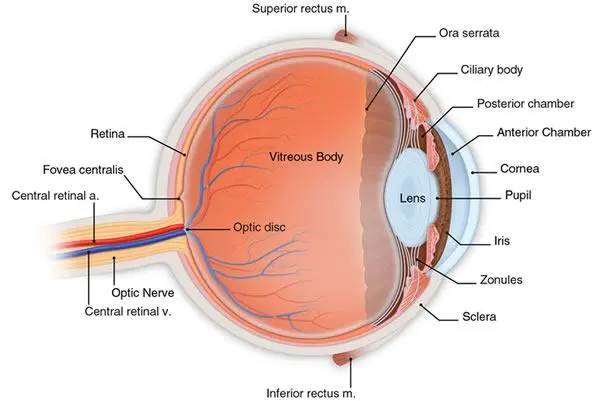Did you know that we hallucinate when we close one of our eyes?
One of the most common optical illusions has to do with identifying the physiological blind spot that is present in each of the eyes. The illusion is extremely simple, and easily replicable on any type of paper. Now we’ll experience it:

Close your right eye, fix the cross in the center of the field of view, and zoom in/away from the screen little by little (it should be very close, between 20 and 30 centimeters), eventually, the circle should disappear. Congratulations! You’ve found the blind spot in your left eye.
Let’s waste a few seconds trying to understand what happened. The ability to see begins, in anatomical terms, in the optical media of the eyeball, which acts as a gateway, the concentration and orientation of the beam, leads to a stream of photons being picked up by the sensitive part of the eye, the retina. Stimulation of this sensitive layer therefore leads to the transduction of a light signal into a nerve signal (which occurs in photoreceptor cells – rods and cones) conducted by the optic nerve to the occipital cortex (at the back of the head).
Well, the retina is a layer of cells, it is its extensions (at the level of the ganglion cells) that will form the optic nerve. It leaves the ocular cavity through the optic disc or papilla (Optics disc in the figure), at this point of nerve emergence, the retina is devoid of photoreceptors; Without the photoreceptors, therefore, there is no stimulation in that area of our visual field, providing a natural scotoma, or blind spot.

Now that we know why the blind spot exists, it is interesting to understand why, or rather, what a blind spot corresponds to. By performing the above illusion, when the dot disappears, that’s it, it disappears. We see white. But does that mean being blind? Another illusion:

Once again, close your right eye, fix the cross in the center of the field of vision, gradually bring your head closer together, analogous to the previous illusion. What do you see?
For those who may still have doubts, being blind is not seeing white. If the illusion is performed correctly, a solid line will be seen at the location of the blind spot. The brain has played a trick on us. The line wasn’t there, and it’s not there.
In this case, with no visual information for the blind spot area, the brain takes over the surrounding area and “fills” the blind spot. The damn brain loves to do this, and it usually gives us the correct perception of reality, based on a series of a priori cognitive knowledge. By seeing a continuous line, the brain assumes that the continuity is maintained along its entire length, creating the illusion.
However, on a day-to-day basis, the blind spot is not a concern. The human body is, fortunately, abundant in paired organs. In the case of the eye, the existence of the other has a surprising functional importance, it is not just one more, it is synergistic. The visual field of one eye overlaps with the contralateral eye in the area corresponding to the blind spot; Binocular vision allows that, instead of a mere brain reconstruction based on the surroundings, information from the other eye is used for that point, leading to a reliable representation. It is no coincidence that any illusion of this kind requires you to close one eye.
But don’t be sad, the vision is full of lies (like stereograms), and despite that, it’s still good. The eye is an extraordinary organ, there is no doubt about it, and no modern camera overshadows it. But it’s just a “tool”, since visual processing happens all in our heads.
